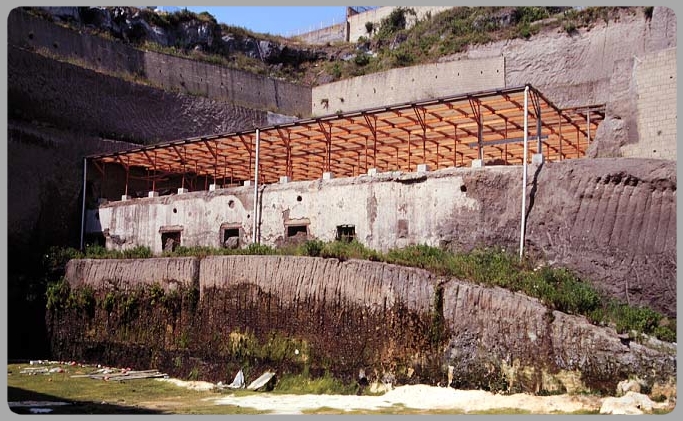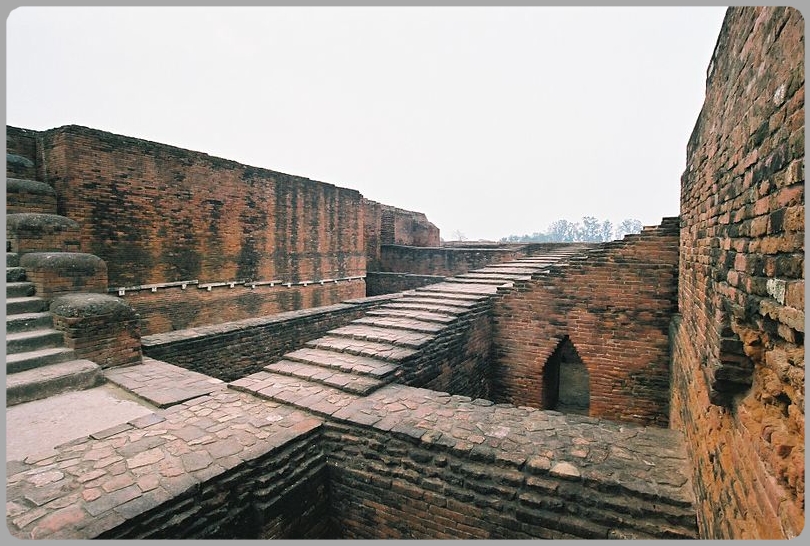Libraries, regardless of whether or not they attach themselves to a university, belong to a public system, or simply sit inside someone's home, exist as an essential vertebrae in society's backbone. These intellectual institutions make knowledge and education accessible to individuals, businesses and cities alike, preventing mental — and, subsequently, collective — stagnation. By no means are they anything new, either! For millennia, libraries of all shapes and sizes have kept humanity puttering ever forward, allowing for some of the greatest innovations ever conceived. Although all but one gradually fell to fire and time, these ancient wonders deserve awe and accolades for everything they've accomplished when it comes to promoting every academic and literary subject imaginable.
-
Villa of the Papyri: Located in Herculaneum, Italy, Villa of the Papyri holds the honor of being one of the few (if not only) classical libraries to mostly survive into modern times — even after the 79 CE eruption of Mt. Vesuvius buried it beneath tons of ash. Unearthed in 1752, archaeologists discovered at least 1, 785carbonized scrolls (from which the site derives its name) still intact on the top level, while the bottom still warrants further exploration. Lucius Calpurnius Piso Caesoninus, Julius Caesar's father-in-law, may have owned the massive home, which overflowed with over 80 gorgeous sculptures (mostly bronze) and some of the era's most stylish architecture. Given the owner's predilection for philosophy, most of the reads featured in his private library were personally selected by his dear Epicurean friend Philodemus of Gadara.
-
The Royal Library of Ashurbanipal: If nothing else about this Assyrian majesty impresses readers, the fact that it possessed the original clay tablets comprising The Epic of Gilgamesh just might. Snuggled in Nineveh, the former empire's capitol, The Royal Library of Ashurbanipal — named after its last significant king — boasted thousands of holdings. The British Museum posits the exact number at around 30,943 surviving examples. Most of these were, of course, clay tablets inscribed with Akkadian cuneiform and covered a broad range of subjects piquing the king's knowledge lust. Historians believe the grand library fell along with Nineveh itself during a 612 BCE raid by the Medes, Babylonians and Scythians. Fires meant to destroy the collections actually baked the clay and kept them preserved for millennia, though the wax reads did not fare so well.
-
Library of Pergamum: Plutarch claims the pivotal Turkish library in ancient Pergamum (now Bergama) kept over 200,000 holdings, but a lack of any known surviving administrative records makes it impossible to really tell. Stories circulate of Mark Antony's emptying the collection onto Cleopatra VII as a seriously cool wedding present, which she then plopped straight into the Royal Library of Alexandria. Fans of biblical archaeology will love visiting its ruins, as St. John of Patmos explicitly mentioned it as one of the Seven Churches of Revelation.
-
Nalanda University: Bahir, India is home to one of the most lauded intellectual circles of the ancient world, with Nalanda University holding tight as its nerve center from around 427 to 1197 CE. Its library, nicknamed "Dharmaganja" ("Treasury of
 Truth") and Dharma Ghunj ("Mountain of Truth"), allegedly burst with hundreds of thousands of texts. During its heyday, Nalanda University was praised as the world's largest collection of Buddhist literature, nurturing followers, new philosophies and helping the faith spread across South Asia. 1193 saw Turkic invaders burn down the prestigious house of learning, and legend has it the library took months before everything ended up destroyed.
Truth") and Dharma Ghunj ("Mountain of Truth"), allegedly burst with hundreds of thousands of texts. During its heyday, Nalanda University was praised as the world's largest collection of Buddhist literature, nurturing followers, new philosophies and helping the faith spread across South Asia. 1193 saw Turkic invaders burn down the prestigious house of learning, and legend has it the library took months before everything ended up destroyed. -
Theological Library of Caesarea Maritima: Before its ultimate destruction in 638 CE (estimated), the Theological Library of Caesarea Maritima existed as the biggest, most influential ecclesiastic library in the ancient world. Among the literary wonders in its possession were The Gospel According to the Hebrews, quite possibly the only complete copy of Hexapla and the works of St. Jerome, Basil the Great and Gregory of Nazareth — among other highly regarded religious philosophers. Both Origen and St. Pamphilus of Caesarea were largely responsible for the over 30,000 works collected, most of them regarding Christianity.
-
Libraries at Ugarit: Located in modern-day Syria, the ancient city of Ugarit boasted at least 5 exquisite libraries. Two of them, one owned by Rapanu (a diplomat), were actually private — quite the rarity for 1200 BCE. One was located at the palace, another to a temple. All of them largely collected clay tablets, and literature covered an incredible range of subjects in at least 7 different languages. Most of them, as one can probably imagine, involved political, legal and economic concerns, but religion, academics and fiction were by no means uncommon topics.
-
Libraries of the Forum: The Forum of Trajan, home of the Bibliotecha Ulpiana, is probably the most famous of the Roman libraries. But by no means should one consider it the only institution worth researching! Both the temple of Apollo Palatinus and the Porticus Octaviae housed their very own libraries, along with many other imperial fora. All of these would collect works in both Latin and Greek — occasionally other languages — and keep them separated from one another for more convenient access.
-
Libraries of Timbuktu: Mali's legendary city once existed as one of the most influential intellectual hubs during ancient and medieval times. As a cohesive unit, the amazing libraries (and university) housed there boasted over 700,000 now-famous manuscripts. These works have garnered far more than a modicum of attention the past few years, owing largely to the fact that they sat mostly hidden for well over a century. Most of the rightfully lauded literary treasures revolve around Islam and Islamic themes and are written in Arabic. Some even contain absolutely gorgeous examples of illuminated manuscripts, too.
-
Library of Celsus: Greco-Roman senator Tiberius Julius Celsus lay buried beneath the library bearing his name, which now sits ruined in modern-day Turkey. This dual heritage was honored in the building's architecture as well as its beautifully stocked shelves. Completed in 135 CE, it housed 12,000 scrolls and may have served as a template for similar buildings now lost to time's ravages. Celus' sarcophagus was quite the anomaly for the time, as few politicians enjoyed the sterling honor of spending eternity at their very own library.
-
Imperial Library of Constantinople: At the heart of the Byzantine Empire sat Constantinople, now Istanbul. And at the heart of Constantinople, now Istanbul, sat one of the most glorious libraries in the history of the world — ancient or otherwise. For almost a millennium, the Imperial Library (established during the reign of Constantius II, which lasted between 337 to 361 CE) kept the Greek and Roman literary tradition alive and accessible. It even boasted an awe-inspiring scriptorium dedicated to preserving and transcribing delicate papyri and other works. Fire, unfortunately, proved its undoing on two different occasions. One incident in 473 destroyed around 120,000 texts, and the Fourth Crusade in 1204 eventually finished the job.
-
The Royal Library of Alexandria: The Royal Library of Alexandria, once the shimmering jewel of ancient Egypt,
 probably pops to most people's minds when the subject of ancient intellectual institutions emerges. Julius Caesar infamously initiated an accident burning it to the ground in 48 BCE, destroying what was then one of the largest repositories of literary, political, legal, economic, academic, philosophical and religious texts on the globe. From the 3rd Century BCE up until the fateful folly, ancient Egypt looked towards the library for knowledge and information. It housed a museum absolutely brimming with artifacts along with its literary holdings. Allegedly, King Ptolemy II Philadelphus desired to see this prestigious institution boast at least 500,000 books, each of which requiring a number of different scrolls.
probably pops to most people's minds when the subject of ancient intellectual institutions emerges. Julius Caesar infamously initiated an accident burning it to the ground in 48 BCE, destroying what was then one of the largest repositories of literary, political, legal, economic, academic, philosophical and religious texts on the globe. From the 3rd Century BCE up until the fateful folly, ancient Egypt looked towards the library for knowledge and information. It housed a museum absolutely brimming with artifacts along with its literary holdings. Allegedly, King Ptolemy II Philadelphus desired to see this prestigious institution boast at least 500,000 books, each of which requiring a number of different scrolls.Courtesy: www.onlinecollege.org (Accessed on 07/06/2011)
